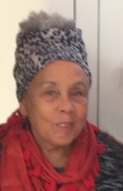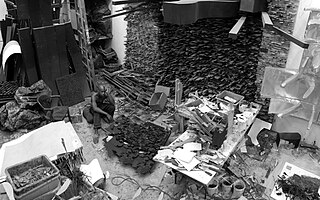
Betye Irene Saar is an African American artist known for her work in the medium of assemblage. Saar is a visual storyteller and an accomplished printmaker. Saar was a part of the Black Arts Movement in the 1970s, which engaged myths and stereotypes about race and femininity. Her work is considered highly political, as she challenged negative ideas about African Americans throughout her career; Saar is best known for her art work that critiques American racism toward Blacks.

The Skowhegan School of Painting and Sculpture is an artists residency located in Madison, Maine, just outside of Skowhegan. Every year, the program accepts online applications from emerging artists from November through January, and selects 65 to participate in the nine-week intensive summer program. Admissions decisions are announced in April. The school provides participants with housing, food, and studio space, and the campus offers a library, media lab, and sculpture shop, among other amenities. The tuition for the program is $6,000, however, aid is available.
Renee Stout is an American sculptor and contemporary artist known for assemblage artworks dealing with her personal history and African-American heritage. Born in Kansas, raised in Pittsburgh, living in Washington, D.C., and connected through her art to New Orleans, her art reflects this interest in African diasporic culture throughout the United States. Stout was the first American artist to exhibit in the Smithsonian's National Museum of African Art.
Chakaia Booker is an American sculptor known for creating monumental, abstract works for both the gallery and outdoor public spaces. Booker’s works are contained in more than 40 public collections and have been exhibited across the United States, Europe, Africa, and Asia. Booker was included in the 2000 Whitney Biennial, received a Guggenheim Fellowship in 2005, and an American Academy of Arts and Letters Award for Art in 2001. Booker has lived and worked in New York City’s East Village since the early 1980s and maintains a production studio in Allentown, Pennsylvania.
Jean Shin is an American artist living in Brooklyn, NY. She is known for creating elaborate sculptures and site-specific installations using accumulated cast-off materials.

Thornton Dial was a pioneering American artist who came to prominence in the late 1980s. Dial's body of work exhibits formal variety through expressive, densely composed assemblages of found materials, often executed on a monumental scale. His range of subjects embraces a broad sweep of history, from human rights to natural disasters and current events. Dial's works are widely held in American museums; ten of Dial's works were acquired by the Metropolitan Museum of Art in 2014.

Sonya Clark is an American artist of Afro-Caribbean heritage. Clark is a fiber artist known for using a variety of materials including human hair and combs to address race, culture, class, and history. Her beaded headdress assemblages and braided wig series of the late 1990s, which received critical acclaim, evoked African traditions of personal adornment and moved these common forms into the realm of personal and political expression. Although African art and her Caribbean background are important influences, Clark also builds on practices of assemblage and accumulation used by artists such as Betye Saar and David Hammons.
Alvin D. Loving Jr., better known as Al Loving, was an African-American abstract expressionist painter. His work is known for hard-edge abstraction, fabric constructions, and large paper collages, all exploring complicated color relationships.

Tom Joyce is a sculptor and MacArthur Fellow known for his work in forged steel and cast iron. Using skills and technology acquired through early training as a blacksmith, Joyce addresses the environmental, political, and social implications of using iron in his work. Exhibited internationally since the 1980s, his work is included in 30-plus public collections in the U.S. and abroad. Joyce works from studios in Santa Fe, New Mexico, and since 2012, in Brussels, Belgium, producing sculpture, drawings, prints, photographs, and videos that reference themes of iron in the human body, iron in industry, and iron in nature.

Leonardo Drew is a contemporary artist based in Brooklyn, New York. He creates sculptures from natural materials and through processes of oxidation, burning, and decay, Drew transforms these objects into massive sculptures that critique social injustices and the cyclical nature of existence.

Simone Leigh is an American artist from Chicago who works in New York City in the United States. She works in various media including sculpture, installations, video, performance, and social practice. Leigh has described her work as auto-ethnographic, and her interests include African art and vernacular objects, performance, and feminism. Her work is concerned with the marginalization of women of color and reframes their experience as central to society. Leigh has often said that her work is focused on “Black female subjectivity,” with an interest in complex interplays between various strands of history. She was named one of the 100 most influential people in the world by Time magazine in 2023.
Jacolby Satterwhite is an American contemporary artist recognized for fusing performance, digital animation, and personal ephemera to create immersive installations and related work referencing art history, "expanded cinema," and the pop-cultural worlds of American music videos, social media, and video games. He has exhibited work at the Minneapolis Institute of Art, the Museum of Contemporary Art, Chicago, Louis Vuitton Foundation in Paris, the New Museum and the Museum of Modern Art, both in New York City, and the Institute of Contemporary Art, Philadelphia. In addition to MoMA, his work is in the public collections of the Studio Museum in Harlem, the Seattle Art Museum, the Whitney Museum of American Art, the Kiasma, and the San Jose Museum of Art. Satterwhite has also served as a contributing director for the music video that accompanied Solange's 2019 visual album When I Get Home and directed a short film accompaniment to Perfume Genius's 2022 studio album Ugly Season.

Ugochukwu-Smooth C. Nzewi is a Nigerian artist, art historian, and curator, currently curator in the Department of Painting and Sculpture at Museum of Modern Art in New York City. He was raised in Enugu and studied under sculptor El Anatsui at the University of Nigeria, Nsukka, before traveling as an artist and curator. In the United States, he completed his doctorate at Emory University in 2013 and became the curator of African art at Dartmouth College's Hood Museum of Art. In 2017, he moved to the Cleveland Museum of Art. Nzewi has curated the Nigerian Afrika Heritage Biennial three times, the Dak'Art biennial in 2014, and independent exhibitions at Atlanta's High Museum of Art and New York's Richard Taittinger Gallery. Nzewi also exhibited internationally as an artist and artist-in-resident.

Victor Ehikhamenor is a Nigerian visual artist, writer, and photographer known for his expansive works that engage with multinational cultural heritage and postcolonial socioeconomics of contemporary black lives. In 2017, he was selected to represent Nigeria at the Venice Biennale, the first time Nigeria would be represented in the event. His work has been described as representing "a symbol of resistance" to colonialism.

Kambui Olujimi is a New York-based visual artist working across disciplines using installation, photography, performance, tapestry, works on paper, video, large sculptures and painting. His artwork reflects on public discourse, mythology, historical narrative, social practices, exchange, mediated cultures, resilience and autonomy.

Hiawatha and Minnehaha are 1868 sculptures by Edmonia Lewis. They are in the collection of the Metropolitan Museum of Art on view in gallery 759.

Sharif Bey is an African American artist, ceramicist and professor. He produces both functional pottery and ceramic and mixed- media sculpture, using a variety of forms and textures. His body of work reflects his interest in the visual heritage of Africa and Oceania, as well as contemporary African American culture. With his colorful large-scale bead sculptures, Bey explores the cultural and political significance of ornamentation and adornment.
Jes Fan is an artist born in Canada and raised in Hong Kong, currently based in Brooklyn, New York. Their work looks at the intersection of biology and identity, and explores otherness, kinship, queerness and diasporic politics. Fan has exhibited in the United States, UK, Hong Kong, and others.

Robert Pruitt is a visual artist from Houston, Texas living in New York City who is known for his figurative drawings and who also works with sculpture, photography, and animation.
Jamal Cyrus is an American conceptual artist who works in a range of media, including drawing, sculpture, textiles, assemblage, installation, performance, and sound. His artistic and research practices investigates the history, culture, and identity of the United States, questioning conventional narratives and foregrounding Black political movements, social justice concerns, and the experiences and impact of the African diaspora, including Black music.
.














